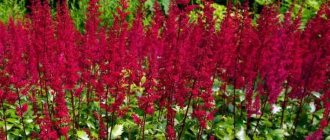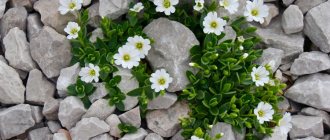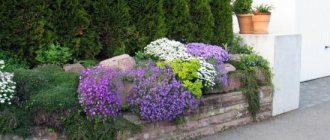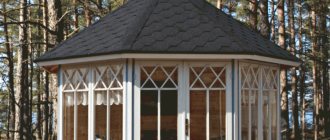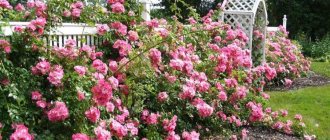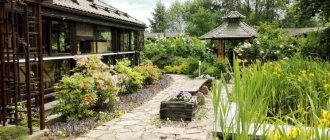Lavender is an exquisite plant with attractive flowers and a subtle aroma. Due to its high decorative qualities, it is often used as part of creative compositions. Lavender in landscape design at the dacha (photos are presented on the website) has been popular among professional gardeners and beginners for many decades. After all, growing fluffy bushes with bright inflorescences is not at all difficult. With its help, amazing compositions are created that impress with their lightness and tenderness.
Helpful information
Lavender is native to areas with warm climates.
To ensure that it blooms beautifully and survives the winter well, varieties that are frost-resistant are selected. Mediterranean varieties are unlikely to survive the cold temperatures of winter.
General description of the plant:
| Characteristic | Peculiarities |
| Root system | Woody, strong, with a developed core system of branches, which are located in the upper layer of soil |
| Foliage | Opposite-sessile, oblong-linear, with a rolled edge. The leaves are densely pubescent, grayish-green. Can reach up to 6 cm in length |
| Inflorescences | Spike-shaped, located at the top of the stems |
| Fetus | Consists of 4 nuts that are attached to the calyx of the flower |
In order for the landscape design to be beautiful, you will need care and quality care.
Before you start decorating with lavender, you need to consider the following:
- The survival rate of the selected species to the environment.
- The plant has a wide variety of varieties. These are tall and low growing species from which you can choose, combine them, and use them for different ideas. Lavender can be used to decorate garden paths and organize hedges with its help.
- The plant blooms in the second half of the summer season.
- Not all types of flowers have beneficial properties.
- For good development, sandy loam soil is more preferable.
- Possible methods of propagation are cuttings, seeds. Growing lavender from seeds is very difficult and labor-intensive. And for cuttings, planting material is cut only from bushes that have reached 3 years of age
To obtain a beautiful landscape design using lavender, you will need care and quality care.
Varieties
One of the main differences between lavender varieties is the shade of flowering. The association of many beginners with the plant is a purple cloud. This is not entirely true. There are blue, pink, greenish tones of flowering
Basically, lavender is divided by professionals into the following types:
1 English
English angustifolia lavender
This variety has other names:
- narrow-leaved (Lavandula angustifolia)
- spica (Lavandula spica)
- officinalis (Lavandula officinalis)
It has narrow foliage and longer inflorescences. Very often used for design decoration of territories. It has good winter hardiness and rapid development. This class does not require digging up the plant for the winter.
The most favorite varieties include:
- Alba
Enchanting abundance of white blooms. It is characterized by rapid, problem-free growth even in areas with cold climates.
- Beechwood Blue
Captivates with its lilac-blue blooms. Has good frost resistance. Winters well in open ground without the need for digging.
Lavender Rosea
- Rosea
It has purple-pink inflorescences and cute fibers on them.
- Gem
Characterized by abundant bright purple blooms. It is often used for organizing living fencing.
The plant, which has a miniature size, is used year-round for interior decoration. The most popular varieties are:
- Nana Alba
- Little Lottie
They are planted in flower pots and placed on windowsills.
2 French
French broadleaf lavender
Latin name Lavandula latifolia (broad-leaved lavender). Characterized by wider foliage with short peduncles.
Characterized by capriciousness. Cannot be outdoors in winter. It is most often used in interior decoration.
Popular varieties include:
- Tiara
- Rocky Road
- Helmsdale
3 hybrid
Hybrid (Dutch) lavender
May also be known as Dutch lavender (Lavandula x intermedia). It is a hybrid of narrow-leaved and broad-leaved lavender.
Grown in industrial production. It has impressive dimensions in height (up to 2 m). It begins to bloom in mid-summer. Characterized by a variety of flowering shades.
Popular varieties:
- Richard Gray (dark purple inflorescences)
- Grosso (purple bloom)
- Alba (snow-white buds)
It will look spectacular in a flower bed with pink roses.
4 serrated or spanish
Jagged (Spanish) lavender
Serrated lavender is not at all frost-resistant. Excellent for growing in areas with warm climates or for indoor conditions. The bush is compact. Silvery patterned foliage.
The flowers are large and fragrant. The smell is pleasant, delicate, between lavender and rosemary. The blooms are excellent with varying shades of purple.
Currently, there are about 47 species of lavender in the natural environment. They differ in the shape of foliage, inflorescences, size of shrubs, resistance to low temperatures, and pests.
Also, more than 40 varieties have been artificially created , but only a small number of them have beneficial properties.
5 multi-incision
Multi-cut lavender
Latin name Lavandula multifidi (multicut lavender). The herbaceous shrub is a heat-loving, unpretentious species. It reaches a height of 60 cm.
In the central zone it is grown as an annual plant. Flowering lasts all summer and until late autumn. Color blue-violet.
Popular varieties:
- Southerner
- Stekhadskaya
Use in landscape design
The dense crown of the subshrub and bright shades of flowers make lavender an advantageous participant in spectacular compositions in the garden. The introduction of this plant into landscape compositions has a number of advantages:
- versatility;
- dense crown;
- frost resistance of many types;
- beautiful flowering;
- pleasant persistent aroma.
Alpine slide: the basis of the organization
In the natural environment of the Mediterranean, lavender grows not only in meadows, but also on mountain slopes. The root system adapted to such conditions allows the subshrub to be used in the formation of rockeries and alpine hills. With this arrangement, a flowering shrub is placed between stones, playing on the contrast of delicate candle inflorescences and rough rock.
Alpine slide Source www.kazportal.kz
Border decoration
Using only lavender, you can effectively design garden paths. In order for such a design to have a well-groomed appearance, it is necessary to take care of the bush, including cutting it correctly and in a timely manner.
Design of garden paths Source pixy.org
Mixboard: best options
One of the conditions for good plant growth and flowering is a sufficient amount of sunny color. This allows you to mix lavender with other plants. The requirements for the “neighbors” in the flowerbed are not to block the sun and not provide dense shade.
The best combinations in one composition are obtained with flowers of these shades:
- pink;
- yellow;
- white;
- deep purple;
- orange;
- blue.
Successful plant combinations Source pinimg.com
Choosing the best companion
A beautiful contrasting duet is achieved by planting lavender and roses in the same area. Pink rose heads and bright purple flowers of lavender subshrubs look very impressive in one composition.
For your information! It is believed that such a mix is optimal in terms of external perception and aroma.
A successful neighborhood with roses Source aquauna.ru
How to arrange a self-sufficient plant
The good thing about lavender is that it doesn’t require choosing companion flowers or creating complex compositions. With proper care, the bushes grow well and look beautiful even against the background of ordinary lawn grass or as a stand-alone decoration.
Advice ! If there is free space on the site, it can be completely planted with lavender.
Tapeworm cultivation Source dachadacha.com
If space is limited: originality is encouraged
For small areas where every square meter is literally worth its weight in gold, you can pay attention to low-growing dwarf varieties. Another option is to plant lavender in containers rather than in open ground.
The unusual choice of container gives the plant a special charm. It could be an antique jug, an old garden watering can or another equally colorful item.
Advice ! The plant grown in containers can be used for landscaping balconies, verandas and window sills.
Compact organization Source cveti-rasteniya.ru
Slope landscaping: practicality and attractiveness
The complex terrain of a site is not a reason to refuse to decorate it with flowering plants. Using lavender in the same way as when creating alpine slides, you can get a beautiful design for a slope or hillock.
For these purposes, you can use the plant either alone or together with others:
- lilac;
- rhododendrons;
- juniper, etc.
Lavender hedge: recommendations for organization
Tall varieties, reaching 0.8-1.5 m, are suitable for organizing hedges. These bushes look beautiful when planted:
- along the perimeter of the site;
- along the fence;
- directly under the house.
For your information ! In addition to their original appearance, lavender bushes have the ability to repel unwanted insects.
Rich color of inflorescences Source res.cloudinary.com
Spicy herbs: friendly neighborhood
In addition to mixboards with brightly flowering plants, lavender in the design of a garden plot can be combined in one composition with herbs. Such a flowerbed will not only have an unusual appearance, but will also spread a pleasant spicy aroma.
Suitable companions for lavender include:
- yarrow;
- mint;
- thyme;
- sage;
- dill;
- oregano and others.
One of the options for organizing a useful flower garden Source fermilon.ru
Watch the video on how to organize landscape design with lavender:
How to “make friends” between lavender and your garden
Planting aromatic shrubs in the garden has not only a decorative, but also a practical function. This circumstance is due to the specifics of the plant. The aroma emitted by flowers prevents the spread of pests on garden crops.
Advice ! The close proximity of lavender to potato plantings prevents the appearance of Colorado potato beetles.
Lavandin
Lavandin
Among the descriptions of all types, it deserves a separate point. It is a hybrid species of true and broadleaf lavender (Spike Lavender). Began to be grown in 1920. This was influenced by economic factors.
The main beautiful differences between lavandin and real lavender:
- Abundant and prosperous growth on lower areas of land (400-600 m), i.e. For cultural cultivation, the plant is an easier species.
- Higher yield levels. The volumes of the obtained essential oil are much larger and the cost is cheaper.
- Less susceptibility to pests and diseases.
- Greater efficiency of decorative qualities, namely greater durability, sharpness of aroma, brightness of violet-blue flowering
Lavandin has lower consumer qualities. The chemical composition does not allow the plant to be used for medicinal purposes in unlimited possibilities. This also applies to essential oils. It cannot be fully used in aromatherapy. Lavandin oil cannot also be used for burns.
Lavandin
Since lavandin has a longer, stronger aroma, using it in a bouquet, laundry sachet, or soap will not cause any problems. For medicinal, aromatherapy, food and cosmetic purposes, it is recommended to use lavender essential oil.
Landing
Favorable places for planting are areas with good sunlight
As mentioned above, before planting, you need to choose a flower variety that will be more adapted (i.e., will not suffer from ambient temperature, humidity) to the climatic conditions of the area.
It is better to plant lavender in sunlit areas. As for the soil, for good development and full flowering, preference is given to sandy loam alkaline soils. To loosen very dense soil compositions, wood ash and lime are additionally added.
In spring, planting begins after the frosts have completely disappeared. For the southern regions, where the winter period is mild, planting is possible in the autumn season in 40-50 days. before frost sets in.
There are several ways to grow lavender:
- seeds
- cuttings
- layering
They usually choose based on whether there is already a bush with a strong root system on the territory or whether the plant is going to be grown for the first time.
Growing Lavender
Growing lavender from seeds is a long process. It begins with the stratification of the material in an artificial way, i.e. The seeds are kept in the cold. To do this, they are mixed in a container with sand, covered with polyethylene and put in the refrigerator for 1.5-2 months.
At the end of the spring season, the material is sown in a greenhouse, a box, where sand is added. With regular moisturizing, everything is kept for another 1 month. Only after all this work has been carried out, the seeds can be placed in open space.
It will take 1-2 years to wait for the first flowering, because... At first, the seedlings will actively grow their root system. Sowing seeds directly into open ground is possible only for areas with warm climatic conditions.
Cuttings are similar to cloning an existing flower. The work begins in spring or summer after the lavender has faded. It must be taken into account that rooting will take approximately 1.5 months.
Young shoots or old ones with young leaves are selected for cutting. They are cut with a knife just below the point from which the leaf (leaf node) grows. The length of the cuttings should be about 6 cm. The prepared material is freed from the lower foliage, dipped in a preparation that stimulates the formation of roots (for example, Kornevin) and planted in a container buried along the upper leaves.
Perlite
Required soil composition for cuttings:
- compost – 1 part
- universal primer – 1 part
- perlite – 1 part
For propagation by layering, material is prepared from an adult plant. For this task, a slightly woody branch is selected. A cut is made in the middle using a sharp knife.
The place with the incision is placed in the ground and sprinkled with earth on top. After 14 days everything is carefully checked for the presence of roots. It will be possible to separate the cuttings from the mother bush and plant them separately when the roots are formed in sufficient quantities.
When planting, it is desirable to preserve the earthen ball on the roots
It is possible to sacrifice a lavender bush for the sake of planting material, provided that the age of the flower has already reached 3-4 years.
To avoid the death of a plant during propagation or replanting, certain conditions must be met:
- the landing pit must have a recess of at least 30 cm
- preservation of the earthen coma on the roots
- use only good soil composition for backfilling
- mandatory covering with mulch (compost, rotted leaves, substrate)
- maintaining the gaps between the bushes, which should be equal to the largest height of the flower
- the base of the trunk should not be covered with soil, which will protect it from rotting
Reproduction at home
There are several ways to propagate the species you like - by seeds, cuttings, layering and dividing the bush. The last option is the most risky, since the plant is quite fragile and can be damaged during careless division. But, given that the bushes grow very quickly, sometimes division is a necessary measure.
Propagation of lavender by seeds
Seeds can be purchased or collected yourself - they remain viable for quite a long time (up to 5 years). Before planting, the material must be subjected to cold stratification for at least 1.5 months. Sowing can be done directly into the ground closer to winter - the seeds are buried shallowly and the soil is mulched.
For planting seedlings at home, the optimal period would be the end of winter - the beginning of spring. It is necessary to prepare a shallow container and fill it with universal soil mixture for indoor plants. Seeds are distributed sparsely, at a distance of 2 cm, since long roots develop first. The top of the bed needs to be sprinkled with soil and watered. The container is covered with film or glass. The soil must be sprayed every day. When the first true leaves appear, the plant can be picked.
Propagation of lavender by cuttings
The fastest way is considered to be cuttings from young green shoots. The procedure is performed in the spring-summer period (no later than the end of July). It is necessary to select a young branch on the bush with two growth nodes and cut off a cutting 12–13 cm long with a sharp knife. All leaves are also removed, except the top. Next, you should treat the cut site with a root formation stimulator, which can be purchased in the store. Planting is done in a small container with prepared soil, which should include organic compost and perlite.
After planting, abundant watering is required, the frequency of which decreases over time. The rooting period lasts 4–5 weeks, after which the plant can be transplanted into a larger container.
Reproduction of lavender by layering
Growing new bushes by layering will take longer - the period of formation of new root systems can last about 3 months. You need to select the lower branch of the bush and place its middle section in a small dug hole (about 10 cm). In this case, the flowering or leafy end should be on the surface. The branch must be secured with a stone or staple and the hole must be filled. The recess area must be watered regularly. After a few months, the new bush can be separated from the mother one and replanted.
Care instructions
Pruning is the most important stage of care
High-quality care for perennial flowers means the following work:
- loosening
- weeding
- covering with a mulch layer
- watering
- pruning
- preparation for winter
It is necessary to regularly loosen and mulch the soil due to the nature of the roots , which require good air circulation when the soil composition is loose. Young bushes are especially sensitive to watering.
Overfilling is not advisable. It can result from rotting roots and yellowing of foliage.
Watering lavender
You need to feed lavender when it begins to bloom. To better prepare the plant for the winter, it is better to stop fertilizing by the end of the summer season. A good, thin layer of mulch makes the use of fertilizer unnecessary.
Another important stage of care is pruning the bushes. It must be done when flowering ends. With its help, a beautiful flower shape is formed and better prepares it for winter.
Given the likelihood of a strong drop in temperature in winter (below -250C), all varieties of lavender, even those with good frost resistance, need to be covered. The most suitable shelter is pine branches.
Diseases, pests
Slobbering Penny
Lavender bushes contain phytoncides, and their blooms have a strong aroma, so they are almost not susceptible to diseases or attacks from harmful insects.
The only pest that the plant cannot protect itself from is the slobbering pennitsa. This is a small cicada. It leaves a white foam on the foliage and uses plant sap as nutrition. They fight the pest by treating the leaves with garlic infusion.
Due to improper watering or waterlogging, the stems and root system can darken and become covered with rot. Affected bushes are dug up and burned.
Lavender in a mixborder
Lavender goes well with any plants that do not block the sunlight. But it looks most impressive next to white, dark purple, blue, yellow, orange and pink flowers (for example, poppy, sage, sedum). This color palette leaves no one indifferent.
- 5 mixborder options for every taste
Some inspiring mixborder ideas for your garden.
Preparatory work for winter
Cover with spruce branches
After the spikelets fade, they are pruned, keeping 10 cm above the ground. If necessary, seeds are collected before pruning.
Next, the plant is watered with mullein solution and covered. Agrotextiles and spruce branches are used for shelter. Heat-loving species are transferred in containers to warm rooms.
Growing a plant from seeds
In this case, stratification is needed, which is carried out in February.
They are planted in a small container, covered with film or something else, and placed in a cold room for one month, observing and removing condensation daily.
Then they bring it to a warmer place and transplant it. The plants bloom next year.
Possible design ideas
Growing Lavender
Lavender has versatility, which makes it possible to use it in the flower garden to create a wide variety of compositions. It will look great anywhere.
The most successful combinations of lavender bushes in the garden will be discussed below.
Alpine slide
Alpine slide
Alpine hill The natural environment of lavender is rocky terrain. For this reason, it will develop excellently and look gorgeous in such places, namely on an alpine hill, rock garden. The tenderness of the bushes located between the stones will, like an airy cloud, enliven everything around you.
Mixborder
Mixborder
Mixborder Lavender bushes can feel great in garden design next to a wide variety of plants. The main condition is that these neighbors do not block the sun, because... the absence of light will depress and deplete the plant. Lavender will have a very original look if you plant red poppies and blue sage next to it as a background.
Lavender also goes best with the following shades:
- pink
- yellow
- white
- bright purple
- orange
- blue
Border
Border
Border A sophisticated, charming arrangement of lavender bushes in a soft lilac shade is created in borders. Everyone, walking along such beautiful garden paths, will receive real pleasure and tranquility from the enveloping delicate aroma.
When creating borders with lavender, you will need to trim the plant regularly to keep it looking picturesque.
Combination with roses
A good combination with roses
Combination with roses This fragrant beauty goes best with roses.
Delicate purple spikelets, enveloping large rose buds, will create a harmonious look in flower beds in the sunniest corners of the garden.
Solitaire (single) plantings
Group planting is like a purple cloud
Solitaire (single) plantings With a huge number of amazing combinations of lavender with other flowers, there is also an excellent option - growing the plant in independent plantings.
Lavender bushes in a group planting, like a purple cloud, will ideally complement a well-groomed lawn, creating colorful islands of vegetation against the backdrop of a green carpet.
Growing in closed containers
Growing in a closed container
Growing in closed containers Lavender bushes planted in containers look very gentle and sophisticated in themselves.
And if you use pots with an unusual design or a unique design as containers , this will allow you to create the greatest creativity in the overall image.
Slope landscaping
Slope landscaping
Gardening of slopes To strengthen the slopes, many gardeners practice growing the following plants:
- loosestrife
- veronica
- rhododendron
- juniper
If you plant lavender between them, this can give the slope an absolutely exclusive look.
Flowerbed combined with herbs
Herb garden
Flowerbed in combination with herbs Arranging a fragrant composition at the dacha is not difficult. To do this, you will need to plant the following herbs next to the lavender:
- dill
- thyme
- rosemary
The good proximity of the culture to various companions provides great opportunities for the manifestation of imagination in creating a fragrant cloud. This corner will appeal to all household members who come and relax here.
Hedge
Beautiful decoration near the fence
Hedge To create a hedge, tall varieties of lavender are used. They will be at least 70-80 cm in height. Favorite varieties include:
- Hidcote Giant
- Melissa Lilac
- Vera
With such a decoration you can not only decorate your summer cottage, but also scare away harmful insects that do not like the lavender scent.
Tall lavender looks equally beautiful near a fence and for dividing an area into zones.
What to consider when choosing?
- It is advisable to start composing a bouquet when the dress and all other accessories have already been selected , since it is important that the flower arrangement be combined with the image of the bride as a whole;
- All elements should be securely fixed so that the bouquet retains its presentable appearance throughout the celebration;
- Ideally, the bouquet is combined with the groom's boutonniere. To do this, you can add several small sprigs of lavender to the boutonniere or make a boutonniere entirely from them;
Idea! The simplest version of a lavender boutonniere: tie several small branches with a thin ribbon and secure a pin behind it.
- The bouquet should be the optimal size so as not to cause discomfort during the wedding. Its height and shape are selected based on the height of the bride. Short girls will be comfortable with a small bouquet in the shape of a hemisphere, while tall girls will suit cascading flower arrangements.
Friendship with the vegetable garden
Natural "enemy" of insects
Lavender is a very useful plant for the garden. It is a natural “enemy” of insects due to the aroma it emits when flowering.
With its help, beauty is created in the beds, and also contributes to the collection of environmentally friendly harvests of garden crops.
Planting fragrant lavender bushes next to potato plantings prevents the appearance of the Colorado potato beetle.
Furniture
And finally, I’ll tell you about my personal experience. I was so inspired by lavender that I decided to add it to my interior. It turned out that with the help of decoupage you can very quickly update a square Ikea table that has been standing on my balcony for a long time as a coffee table: it is white, so I didn’t even have to tint it. I took a decoupage napkin, cut out four identical lavender bouquet arrangements, and glued them to each edge of the table using clear nail polish. Then I completely covered the table with several more layers of clear varnish - and voila, it was transformed literally before our eyes! How do you like it?
Lavender is an exquisite plant with attractive flowers and a subtle aroma. Due to its high decorative qualities, it is often used as part of creative compositions. Lavender in landscape design at the dacha (photos are presented on the website) has been popular among professional gardeners and beginners for many decades. After all, growing fluffy bushes with bright inflorescences is not at all difficult. With its help, amazing compositions are created that impress with their lightness and tenderness.
Beautiful indoor plant
Beautiful and fragrant decoration not only for the garden, but also for the home
To grow lavender bushes at home, use purchased plants.
When choosing a future pet, you should carefully examine it. Foliage and stems should be free from damage and insects. The root system should be clearly visible and light. Roots hidden in the ground indicate a recent transplant. In such a situation, it is unknown whether the plant will take root.
For the first few days after purchase, the flower should stand in a sunny place. He will need proper care. Afterwards it must be transplanted into a larger pot. Drainage is poured at the bottom, and sand and peat are placed on top. The transplanted plant is watered with the addition of fertilizer.
Further care for the flower is the same as for a plant grown in open ground.
Autumn is a dormant period for lavender. At this time, watering and fertilizing are reduced. The plant is moved to a cooler corner and lightly pruned.
Growing lavender in a container
Young bushes and low-growing varieties of lavender are suitable for growing in containers. To make the plant look even more attractive, plant it in an unusual pot.
Application
A priceless gift of nature
Lavender bushes are a priceless natural gift. The culture is widely used by cosmetologists, pharmacists, perfumers, and culinary specialists for its beneficial properties.
In folk medicine, narrow-leaved lavender is used. It has the following properties:
- regenerating
- bactericidal
- antiseptic
Lavender flowers are used to make oils. They are added to solutions for inhalation and to medications for the prevention of influenza.
Cosmetological lavender oil is used in skin and hair care products (shampoos, creams, balms). It provides protection, nutrition, strengthening.
Uses of lavender
Broad-leaved and medicinal lavender is used in cooking. It is added when preparing sauces, soups, fish dishes, and smoked meat. Lavender flowers are brewed in healing infusions and tea.
Lavender during flowering fills everything around with a wonderful aroma. It creates a beautiful view in parks and gardens. The swaying of lilac-violet flowering bushes in park areas is like waves that scatter along the paths. She creates magical images of landscapes, captured by numerous artists and photographers around the world.
Lavender bushes in landscape design can create beautiful, irresistible compositions. In addition, the plant is unpretentious in care. Using these bright flowers in your garden will amaze you with its original, light Mediterranean look.
Using a little imagination will help you easily find suitable companions for the plant, and simple recommendations from professionals will suggest the most suitable place for planting, where lavender will quickly and easily grow, develop, and delight everyone around with its appearance.
Peculiarities
Since in the wild lavender settles on the slopes of hills and mountains on light sandy soils, it should also be planted in an open place in loose soil. Lavender does not bloom in a shaded place, and on heavy soils it is prone to rotting.
Even severe frosts will not hinder its development, but excessive soil moisture will. Rather, it will tolerate drought more easily than excess moisture, so high-quality drainage and periodic drying can be a good help in combating this problem during the rainy seasons.
Regular watering of lavender is necessary only in the first months of its development and growth. Pruning should be small; severe pruning will seriously damage the plant.
Lavender cannot stand proximity to weeds, which take nutrients from the soil and deplete it. Over time, this can lead to its death, so regular weeding should be included in your to-do list.
PHOTO GALLERY
Video: Reproduction and planting of lavender
Photo
A bouquet of lavender in the hands of the bride is a wonderful wedding accessory. Many people prefer it for its beauty and versatility. You can create many unusual combinations with it:


